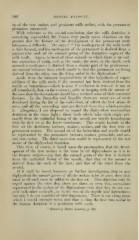Page 490 - My FlipBook
P. 490
500 DENTAL ANAT03rY. ;
up of the true molars and persistent milk rnolars, ^^'itll the permanent
premolars subtracted.
With reference to the second conclusion, that the milk dentition is
something superadded, Dr. Tomes very justly raises objection on the
ground that the history of the development of the permanent teeth
interposes a difficulty. He says : ' " The tooth-germ of the milk tooth
is first formed, and the tooth-germ of the permanent is derived from a
portion (the neck of the enamel germ) of the formative organ of the
milk tooth. Again, in most of those animals in which there is an end-
less succession of teeth, suc:h as the snake, the newt, or the shark, each
successive tooth-germ is derived from a similar part of its predecessor
the natural inference from whicdi would be that the permanent set, being
derived from the other, was the thing added in the diphyodonts."
Aside from the inherent improbability of this hypothesis of super-
addition of the milk teeth, if the mammal has been derived from the
reptile or batrachian—which is true if evolution is true—it is not at
all remarkable, but, on the contrary, quite in keeping with the nature of
the case, that the descendants should have retained some of their ancestral
features. In the Batrachia and Reptilia there are many sets of teeth
developed during the life of the individual, of which the first arises de
novo, and all the succeeding ones are derived from that which precedes
Altogether, I am disposed to regard the diphyodont manmialian
it.
dentition in the same light : those teeth which take their origin pri-
marily from the epithelial lining of the mouth are strictly homologous
with the first set of the lower vertebrates. This would include in the
first set the deciduous incisors, canines, molars, and the first true or
permanent molars. The second set of the batrachian and reptile would
be represented by the permanent incisors, canines, premolars, and sec-
ond true molar. The third succession would be represented by the last
molar of the diphyodont dentition.
This view, of course, is based upon the presumption that the devel-
o])ment of the true molars is the same in all diphyodonts as it is in
the human subject— viz. that the enamel germ of the first is derived
from the ejiithelial lining of the mouth ; that that of the second is
derived from the neck of the first; and that of the third from the
second.
If it shall be found, however, on further investigation, that in any
diphyodont the enamel germs of all the molars arise fJe novo, then they
nnist in all' such cases be added to tlie first set. This objection may be
urged against the view that there are three, or even two, successions
re])resented in tiie molars of the diphyodont—viz. that they do not suc-
ceed each other vertically, as in the case of the reptile and batrachian
;
but this I do not consider of vital importance. There is one thing upon
which I would strongly insist, and that is that the first true molar in
the human dentition is a persistent milk tooth.
' Manual of Dental Analoimj, p. 302.


